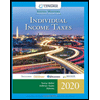
a.
Introduction:
M’s amount of income and gain recognized and the partner's basis in the partnership immediately after the contribution including the allocation of liabilities
b.
Introduction: Partnership forms when more than one person thrives to achieve the same objective as a business. The only difference between a partnership and a corporation is that the corporation will enjoy the benefits of limited liability but faces dual taxation first at the company level and second at the shareholders level, whereas in partnership, partnerships are taxed only at the partners level. Registration of partnership is not mandatory as it can be formed by mere handshake only. To carry a partnership with limited liability, it is important to register the business as a “limited liability partnership”.
S’s amount of income and gain recognized and the partner's basis in the partnership immediately after the contribution including the allocation of liabilities
b.
Introduction: Partnership forms when more than one person thrives to achieve the same objective as a business. The only difference between a partnership and a corporation is that the corporation will enjoy the benefits of limited liability but faces dual taxation first at the company level and second at the shareholders level, whereas in partnership, partnerships are taxed only at the partners level. Registration of partnership is not mandatory as it can be formed by mere handshake only. To carry a partnership with limited liability, it is important to register the business as a “limited liability partnership”.
L’s amount of income and gain recognized and the partner's basis in the partnership immediately after the contribution including the allocation of liabilities
Want to see the full answer?
Check out a sample textbook solution
Chapter 10 Solutions
Income Tax Fundamentals 2020
- A $100,000 5-year 6% bond is issued on January 1, 2026. The bond pays interest annually. The market rate is 7%. What is the selling price of the bonds, rounded to the nearest dollar? Question 6 options: $104,213 $95,900 $100,000 $4,100arrow_forwardA $100,000 5-year 6% bond is issued on January 1, 2026. The bond pays interest annually. The market rate is 7%. What is the selling price of the bonds, rounded to the nearest dollar? Question 6 options: $104,213 $95,900 $100,000 $4,100arrow_forwardDell Industries has a normal capacity of 30,000 direct labor hours. The company's variable costs are $45,000, and its fixed costs are $27,000 when operating at normal capacity. What is its standard manufacturing overhead rate per unit?arrow_forward
- Which statement about a "treasury shares" is correct? Question 10 options: These shares continue to have voting rights. These shares must be cancelled upon re-purchase. The company does not pay dividends on these shares. These shares are disclosed as issued and outstanding.arrow_forwardWhich statement best describes the accounting when a company cancels its own shares at an amount higher than the average share value? Question 9 options: Contributed surplus and retained earnings will be debited. Contributed surplus will be debited, thereby decreasing equity. Contributed surplus and retained earnings will be credited. Contributed surplus will be credited, thereby increasing equity.arrow_forwardWhich statement is correct? Question 8 options: A corporation need only pay dividends when it declares them to be payable. A company can avoid a cumulative dividend on preferred shares if it declares dividends on common shares. Dividends are never discretionary payments. Companies must pay the shareholders interest to compensate for the time value of money lost on the deferral of dividend payments. No entryarrow_forward
- Which statement is correct about the derecognition of a matured obligation? Question 7 options: There will be a gain on retirement. There could be either a gain or loss on retirement. There will be no gain or loss on retirement. There will be a loss on retirement.arrow_forwardWhat is a bond indenture? Question 5 options: Guarantee of the price to the borrower. Promise from the borrower to restrict certain activities. Contract that outlines the terms of the borrowing agreement. Feature that permits the borrower to redeem before maturity.arrow_forwardWhich of the following would be a "non-current liability"? Question 4 options: Payment due to a supplier 45 days after year-end for supplies received before year-end. Payment due to a supplier in 18 months for goods to be received 3 months after year-end. Payment due after 3 years, on which the debt covenants have been not been violated. Payment due after 3 years, but the company has violated the debt covenants. Previous PageNext Pagearrow_forward
 Individual Income TaxesAccountingISBN:9780357109731Author:HoffmanPublisher:CENGAGE LEARNING - CONSIGNMENT
Individual Income TaxesAccountingISBN:9780357109731Author:HoffmanPublisher:CENGAGE LEARNING - CONSIGNMENT





